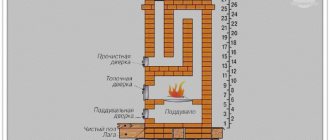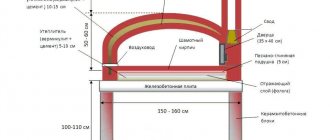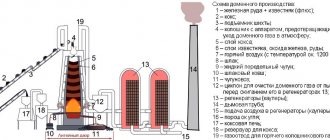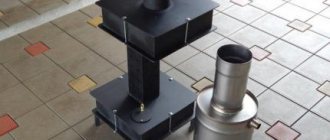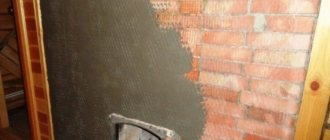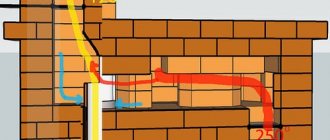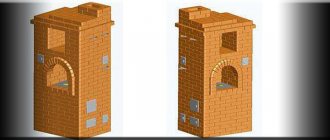Brick stove for cauldron
Brick and stone are durable building materials. Their use in masonry is practical. A stove for a brick cauldron can be built by an ordinary worker who has a technical mind and can read the order drawings. And if you know a stove maker, then the issue is easily resolved.
You can find many detailed instructions on the Internet. The design of the system is simple. No heavy, dirty work on foundations is required. Simple masonry is used.
There are several types of brick stoves. The main task is to promote strong, uniform heating of the boiler walls. What stove layers don’t do to ensure uniformity of heat supply to the boiler.
Classic versions of combustion boilers, a vase-like shape, and an inverted pyramid are the main tricks that craftsmen go to in order to obtain even heat.
How to choose a cauldron with an oven
A cauldron is a thick-walled cast iron cauldron with a semicircular bottom, convenient for cooking food over a fire.
The spherical bottom is made in such a way that the flame heats all the walls of the container, and not just the bottom of the cauldron, and food does not get stuck in the corners of the dish. Thick cast iron walls prevent food from burning, and all ingredients simmer slowly.
It should be noted that nowadays a cauldron is mistakenly called for dishes that are not related to its varieties, for example, a cast iron pot, a duck pot, a cauldron. Although they are similar in their properties and appearance to a cauldron, they do not meet the main requirement - a rounded bottom.
Modern types of cauldrons can have a non-stick or ceramic coating, and be made of aluminum or steel. However, a thick-walled cast iron cauldron is still considered the best. It can be placed on a special tripod (tagan), under which a fire is lit, or placed above the hearth - a stove for a cauldron.
The cauldron is intended for:
- Cooking soups, stewing, boiling water.
- Preparation of traditional dishes “with smoke”: triple fish soup, grenadier kulesh, tourist konder, etc.
- Cooking traditional oriental dishes.
The cauldron has thick walls and a spherical bottom. Naturally, don’t expect stability on a flat surface from it.
The round shape implies a ring-shaped stand. Do not try to install it on a regular grill grate, or on an outdoor barbecue grill.
If a cauldron with a flat bottom heats up faster from below than along the walls, then the heat spreads evenly throughout the cauldron. Moreover, the material used for its production is thick steel or cast iron.
For various dishes and cooking methods, it is advisable to use cauldrons of a specific shape.
The depth is equal to the largest diameter of the container along the edge (Asian dishes in stone ovens). The ratio of depth to diameter is about one to three (Asian dishes in factory-made metal ovens). Almost a cylinder with a rounded bottom (thick tourist dishes with smoke). A shallow container with sloping walls and a small plane at the bottom (cooking, boiling).
As for sizes, there are no restrictions. But based on the materials – very much so. Cast iron is ideal. Due to its massiveness and heat capacity, it provides uniform heating; the pores of its walls “self-heal” over time with a fat layer. Products in such a cauldron glide and do not burn.
Material for making the cauldron:
- Cast iron is ideal.
It is massive and has a high heat capacity. Due to this, the food is heated evenly. As it is used, “self-healing” of the pores on the walls occurs due to the fat layer.
Due to the layer of fat, the products in the cauldron do not burn. In the East they say that in an old family cauldron, the taste and aroma are transferred from one dish to another.
- The only alternative to cast iron is thick-walled aluminum.
- Copper, stainless steel, and modern products with non-stick coatings are not suitable. It is unlikely that a traditional oriental dish will turn out in such a cauldron.
A cauldron stove is an indispensable item in everyday life for lovers of delicious foods cooked in a cauldron for a number of reasons:
- Firstly, of a technical nature: a cast iron cauldron most often has a convex bottom.
- Secondly, it is the cauldron oven that ensures uniform heating of the cauldron from all sides.
- Thirdly, and no less important, nothing can replace an open, live fire - dishes prepared in this way have a unique taste and aroma.
Such an oven will comfortably accommodate not only a cauldron, but also a pot and a frying pan - enough to throw a real holiday and cook many magnificent dishes right at the place of rest.
Thanks to its collapsible design, the stove is indispensable for fishing, at the dacha, on a hike or in nature; it can easily be placed in a gazebo or outdoors.
It does not take up much space in the trunk and is easy to assemble (the firebox, or the “body” of the stove, the legs, the “tongue” - holds the ash, ensuring order in the area, and helps when cleaning the stove, and the pipe - removes smoke from food).
The design of a cauldron stove may be similar to any other stove, but its main difference will be the hole in the cast iron plate where the cauldron itself will be placed.
The fact is that, according to the rule, this hole should have such a width that the cauldron fits 2/3 below the level of the stove. If the hole is made wider, the cauldron will be inconvenient to take out. If you do it narrower, the surface of the cauldron will not heat up evenly.
Today there are special plates with rings of different diameters, thanks to which you can use dishes of any size. But the main purpose of such a stove is to cook food in a cauldron.
We also note that the stove for the cauldron is multifunctional, because you can not only cook various dishes in it, but even boil water or fry shish kebab.
For the latter, by the way, an iron rod is laid across the slab on which skewers are hung. As a result, the hot coals will cook the meat as evenly as possible.
The oven can be of several types:
- made of brick;
- converted from another metal device;
- sculpted from clay.
Before you begin, complete the following preparations:
- draw on paper all your thoughts regarding the design of your cauldron stove;
- determine the exact dimensions of the structure;
- decide on the form;
- Decide what material you will build the stove from - metal (pipe) or bricks. It is worth noting that a brick-based structure will be safer; this is an important characteristic if you have children;
- Decide whether the oven will be portable or stationary.
Like a regular barbecue, these stoves come in two types. The portable one will be convenient and transportable, and the stationary model will fit perfectly into the exterior of your site.
In addition, a stationary oven-barbecue under a cauldron will work more efficiently and is economical in terms of maintenance. If you plan to organize gatherings mainly on the site, then it is better to choose this option.
At the preliminary stage, it is important to decide what kind of cauldron stove you want to have on your site.
The stationary option is suitable for those who often use such a device and have the opportunity to allocate a large area for it.
Moreover, it should be distant from the main buildings. In this case, a solid brick foundation is laid for the cauldron, or more precisely, for the stove, on which the huge vessel stands as if on a pedestal.
For a mobile version, you can make a stove out of metal.
Its design is extremely simple. The role of the pedestal in this case will be played by the upper part of an ordinary iron cauldron. A large cast iron pipe or a heat-resistant steel pipe will be suitable as the main material.
A mobile oven creates conditions for rare culinary forays and allows you to make the most of the possibilities of a compact outdoor patio.
Both options are easy to assemble with your own hands.
If you are planning to build a barbecue stove for a cauldron made of brick, then the work ahead will be very difficult. However, if you choose a metal pipe structure, the work will be much easier.
If you have a ready-made grill, but you want to adapt it for cooking dishes in a cauldron, then place a special stand on it in the form of a mini-stove, which you can assemble with your own hands or purchase in a store.
No special fuel is required, but the maximum amount of coals should be raked under the cauldron. However, it is worth noting that on the grill oriental dishes like pilaf will not have the traditional “zest”, but dishes with smoke in a cauldron on the grill will turn out excellent.
Cast iron stove for cauldron
Cast iron is one of the best materials for a stationary system. Massiveness and strength contribute to a long service life. Moisture does not affect cast iron. A huge advantage of using this metal is its flexibility.
Any shape can be cast, any size, appearance can be any. The chimney can be made permanent or removable. The body is placed on the ground. Possibly on legs. Heat in a cast iron stove is distributed evenly.
The simplicity of the design allows you to make a small oven. In this case, the oven becomes mobile. To put it simply, this is a piece of metal pipe, similar in shape to a potbelly stove, only without a top (if it is missing, a cauldron will replace it). The oven dimensions are arbitrary. The diameter of the cauldrons that are placed on the stove can be adjusted using adapter rings. Rings are added or removed depending on the diameter of the cauldron.
It is best to take cast iron stoves with the thickest possible walls. The system will keep warm for a long time, and most importantly, it will last for many years. The uniformity of heat distribution also becomes a big plus when choosing a cast iron stove.
Pipe cauldron stove
The thickness of the metal firebox wall is an important factor that determines the service life of the product. Thick sheet metal will last significantly longer than thin sheet metal.
The powerful wall perfectly accumulates thermal energy and then transfers it to the cauldron with food. Metal heat generators are similar in their properties to cast iron bodies. Metal has only one drawback, compared to cast iron, and that is susceptibility to corrosion. Therefore, it is best to coat the metal surface with a protective compound.
Mobile stoves are needed by people who often travel outdoors. These are hunters, fishermen, fishermen, gas workers, oil workers, geologists, tourists, summer residents (at the beginning of the season it is brought to the country house, and in the fall it is taken away). Of course, there is not a wide variety of materials for mobile options. The list of mobile ovens is limited to metal models.
The main advantage of such a stove will be mobility and durability. Mobile stoves differ from stationary ones in the thickness of their walls. If the system is stationary, the wall thickness is 3 mm, and the mobile structure is made of steel 2 mm thick. There are mobile installations made of powerful hardware.
What is a cauldron
Kazan is a traditional Asian cast metal cauldron with a semicircular bottom for cooking.
A cauldron is a cauldron, the lower part of which is shaped like a hemisphere. Thanks to this shape, it can be lowered into the hearth, which creates an even distribution of the applied heat.
The boiler can be made of heavy but very durable cast iron or lighter aluminum. Its dimensions vary: from small options of 2-3 liters to massive ones of 10 or more. In small cauldrons (up to 8 liters) you can cook on a standard stove if you purchase a special stand. Massive boilers require a furnace.
The thickness of the walls of the dishes depends on the material from which it is made. If it is cast iron, they can be thin (2-4 mm). The aluminum cauldron has thick walls (approximately 10 mm), which prevents food from burning and ensures better heat retention.
Stove for a cauldron made from wheel rims
A do-it-yourself stove for a cauldron is made from car rims. This is a simple and quick way to make a firebox. If you have basic welding skills, then there is no need to hire an outside specialist. When you pick up wheels at the nearest car depot or garage, take into account the future dimensions of the boiler. For a large pot, disks from a truck with a diameter of half a meter and a disk height of 25 cm are suitable. If the stove is small, then disks from small cars are suitable.
A feature of this product design is the simplicity and speed of production of the final product. This can be done without significant costs for transport (transportation of metal sheets), cutting, chopping of metal, consumables (grinder wheels). We do not waste time on marking, joining, tacking sheets and other installation work. The large Taganka version is installed on the back side of the discs.
The front side of the disk is cut out completely, and the parts are connected to each other by welding. The element with the cut out fragment is welded to the back side of another element. The system leaves plenty of space to accommodate an armful of firewood.
Products for a cauldron made from car rims have the following advantages:
- Car wheels are made of powerful steel. The walls do not fade with frequent, prolonged heating. No deformation after exposure to extreme temperatures.
- Legs for such a heat generator are not required; it is stable by default.
- The stove can be used 24/7, the strength of the structure is off the charts.
- It is easy to obtain material for the production of a boiler. By going to any garage or car depot, you will receive them for free. They will gladly give you your old discs. Rest
- Find material in landfills behind garages. An additional disk will increase the volume of the firebox without significant financial costs (and sometimes for free).
- Any utensils can be placed on stoves of this type (the main thing is that the size is appropriate).
- The high level of thermal output of the disks will allow you to heat garages and utility rooms without additional costs.
- When we start making a stove from car wheels, we need to know where the entire structure will stand. After this, you can begin preparatory work.
Preparation of material and project development
So, when a cauldron has been purchased and nearby metal collection points have been warned of their intentions to buy a meter-long piece of pipe with a diameter of 500-600 mm with thick walls without visible defects and deformations, it’s time to start preparing the drawing. More precisely, the graphic part of the plan for building a stove for a cauldron with your own hands.
Why do you need a plan? In order to foresee all the subtleties of the design with a pencil in hand, and on paper to correct mistakes that may be made during the creative process. The plan provides and calculates the following important points:
- Height of the oven;
- Location of the firebox doors and ash pan;
- Options for locking devices and door handles;
- What shape will the carrying handles be, where to attach them and how to make them;
- How will the stove be installed on the ground, will it need legs or other fixing elements;
- How the grate will be made, whether it will be removable and at what height it should be attached to the body;
- How the chimney pipe assembly will be made, how the pipe will be welded, to what height it will rise;
- Will the pipe have an open top or will a baffle be installed on it?
Drawing out all these elements will take a little time, but it will save both time and resources.
Making a stove for a cauldron from sheet steel
A brazier with a stove for a cauldron made of sheet steel should be started after a series of preparatory work. First, take a cauldron based on the volume that will be cooked. Having a boiler in hand, we will know the diameter of the future furnace.
We will need:
- welding machine with electrodes;
- thicker sheet steel;
- metal corner for supports, handles;
- Bulgarian;
- drill.
All work is done outdoors, next to an electrical outlet. Safety rules during work are mandatory.
Manufacturing stages:
- We measure the circumference of the boiler and the diameter. We will start from this size.
- Using a grinder, cut out a piece of steel from a sheet of steel equal in length to the diameter of the pot. Make a hole in the cut piece.
- In the upper sector of the barrel we mark and make several cuts to ensure complete release of smoke. In the lower segment of the barrel we cut out a square shape to accommodate the firewood.
- We roll the sheet into a cylinder. Choose an object of a suitable shape. Wrap a sheet of steel around it. Use a hammer to give precision to the body. Use tools for bending metal sheets.
- We cut out handles and supports for the walls of the stove from a steel corner. Using a welding machine, we weld the surface of the sheet into a cylinder. Next, we weld the bottom, supporting parts, and handles. In the absence of welding, bolted connections can be used. To do this, you need to make the required holes in advance.
Important point! To protect the stove from through corrosion, cover it with a heat-resistant compound, applying several layers.
After drying, the product is completely ready for use. Load the fuel and light the fire. The system can be improved. Grate bars, ash pans, doors and chimney pipes will not be superfluous items. The production process will be similar to the previous process. Taking into account the addition of several steps.
- It is worth cutting not only the combustion hole, but also adding another, smaller one. Cut it out from the bottom. This hole will act as a blower. We cut an additional hole at the top of the barrel. We will insert a chimney into it.
- We place grates between the ash pit and the firebox. To do this, we will weld parts of the corner - the support - from the inside of the barrel. For a regular grate, wire rod or reinforcement is suitable; in extreme cases, wire. Fold the wires together and weld them using a welding machine. There is no need to cook the grates at the corners.
- Let's cut the pipe for the chimney. The height must be greater than the person's height. This is done to prevent smoke from getting into your eyes. We weld the pipe to the surface.
- Let's make a simple spark catcher. A regular tin can will do for this. We make several holes in it for the smoke to escape.
- We make doors for the firebox from sheet steel and weld them to the body.
As a result, we get a convenient design. Of course, this is not a barbecue oven for a gazebo, but it is also a good design. Our stove is easy to maintain. Loading fuel and cleaning soot will be a pleasure. The smoke will exit through the chimney system, the draft will be regulated through the blower door. The system is not so convenient for transportation due to its dimensions.
How to make it yourself
The process of installing a stand under a cauldron depends on the complexity of the design. The simplest option is an earthen hearth, which does not require special materials or time. The most labor-intensive is the manufacture of a brick stationary kiln.
Made of brick or cobblestone
Simplified designs look like square or rounded “wells”. Sophisticated multifunctional varieties have additional modules: drying, stove, smokehouse, barbecue. The master will need: brick, clay, sand, water, asbestos, fittings. The work is done step by step:
- pour a concrete base up to 12 cm thick and strengthen it with reinforcement;
- masonry mortar is prepared from clay, sand and asbestos;
- rows of bricks are laid along the intended perimeter, rubbing the seams with mortar;
- a hole is made on one of the top rows for air circulation;
- Allow the structure to dry completely.
Each row of masonry must be checked with a level.
From a metal pipe
The diameter of the selected cylindrical workpiece must correspond to the size of the cauldron. In addition to the main pipe, you will need a metal sheet, fittings, hinges, and a pipe with a diameter of 10–15 cm for the chimney. The technology consists of the following stages:
- make a drawing indicating all dimensions;
- a cylinder of the required length is cut from the pipe;
- a hole is made on the side for a fireplace with a door;
- weld the hinges and hang the door on them;
- a window is cut out from below for the lower rod;
- a circle is cut out of a metal sheet according to the diameter of the pipe;
- weld the cut out bottom to the cylinder;
- a chimney pipe is installed on the side;
- A tripod is made from the reinforcement and fixed to the base.
The finished metal hearth can be coated with fireproof paint.
Earthen hearth
This is one of the most ancient types of hearths, although it has not lost popularity in modern times. Its construction does not require expensive materials or complex tools. All you need is a shovel, stone, clay. The technique includes several stages:
- make a hole in the ground of the required size;
- install a cauldron in the pit;
- the walls of the container are lined with stone;
- cover the cracks in the masonry with clay;
- two tunnels are made to the pit for traction.
The technology is simple, as it does not require special construction skills. An earthen structure is convenient as a temporary structure when you need to cook food for a large number of people, since small ovens do not require the installation of a huge cauldron. This type of fireplace is also in demand in camping conditions.
A fireplace for a cauldron is a popular structure that allows you to expand your gastronomic palette and turn the process of cooking into a real holiday in the fresh air. Both stationary and portable copies are suitable for this. If you want to use a homemade oven rather than a factory oven, you can make it yourself. The complexity of the work depends on the type of stand and materials chosen.
Stove for a cauldron from a cylinder
When you often travel outdoors or go to the country, it is advisable to have a small portable stove on which you can fry and cook food. To make such a stove, an old gas cylinder will come in handy.
The cylinder can be used, with holes, with slits. It doesn't matter to us. During production, the main tools will be a grinder and a welding machine. An important point is to cut the balloon carefully.
There may be residual gas there. Before cutting, it is better to fill the container with water. There are many detailed videos on the Internet about a cylinder stove. In our version, the main thing is to adapt it.
Complex barbecue with a stove for a cauldron
A brazier with a stove is a complex system that combines a separate stove for a cauldron along with a classic brazier. The advantages of this solution are the efficiency of cooking in a cauldron. The separate stove fits much more firewood, giving more energy to the cauldron.
There is a lot of free space above the fryer, which allows you to fry meat on skewers, grill, or spit. They are highly resistant, durable, using thick metal and a one-piece body.
The structures have a stationary installation type. In some models, the stove option is a barbecue with a roof and a stove for a cauldron. In another type of execution, we get a barbecue oven with our own hands. If you make the roof large enough, you will get a version of a gazebo for a summer house with a stove and barbecue.
How to use it correctly?
Before you start cooking, you must first remove the cauldron from the stove and heat the inside of the device using a small portion of firewood. In this way, you can eliminate any remaining odors and check the tightness of the installation of doors and chimneys.
During further operation, observe the following rules:
- when fuel burns, the surface of the container and its legs are completely heated, therefore, to ensure fire safety, the structure must be installed on a thick sheet of metal;
- regularly clean the oven from ash residues;
- use only solid fuel for heating. It is strictly prohibited to pour liquid petroleum products into this model of furnace;
- limit the access of children and animals to the heated device;
- do not place the stove near flammable objects;
- Do not light the stove with flammable liquids;
- such a stove is not suitable for burning household and construction waste;
- it is advisable to use only dry firewood, since when raw wood burns, drops of condensation will form and settle on the working elements of the device;
- equip the stove chimney with a spark arrester in the form of a tin can with a large number of holes made with an awl.
Cooking
Laying a stove for a brick cauldron
The cauldron truly reveals its capabilities in a brick oven. The services of professionals are highly valued. In our version, we will consider a simple design that does not require significant costs.
The advantages of the design are as follows:
- The design can withstand any weight of dishes;
- Uniform heating of the cauldron;
- Short cooking time;
- People around you are not affected by the smoke;
- The burnout process is controllable;
- Low fuel consumption;
- Can be heated in any weather;
- The risk of fire is minimal;
- Costs are minimal;
- Durable design.
We build a stove for a cauldron
To start building a barbecue with a brick stove for a cauldron, you need to select a design and prepare a drawing indicating the dimensions and order. See the order below. The laying of fireplace stoves is carried out by specialists, but it is expensive.
We will place the firebox at a height of slightly less than a meter. Separately, we will draw a metal chimney, in all general dimensions, and in individual parts. It is important to find a place on the site that was convenient for you and did not disturb your neighbors with smoke. At the same time, the stove must fit into the landscape of your site.
conclusions
To cook food in a cauldron according to canonical recipes, you need a special oven. You can buy a ready-made one, but it will either be expensive or pointless, you can weld it yourself “from what you have,” you can lay it out of brick with your own hands - it’s not that difficult.
We offer our article, which tells in detail how to build a universal brick structure with a stove for a cauldron, a barbecue and an analogue of a Russian stove. Read how to make a brick barbecue with a stove for a cauldron. Look at the options for metal cauldron stoves. And in the video there is a street complex with an ancient Aryan oven.
Subscribe to our Telegram channelExclusive posts every week


